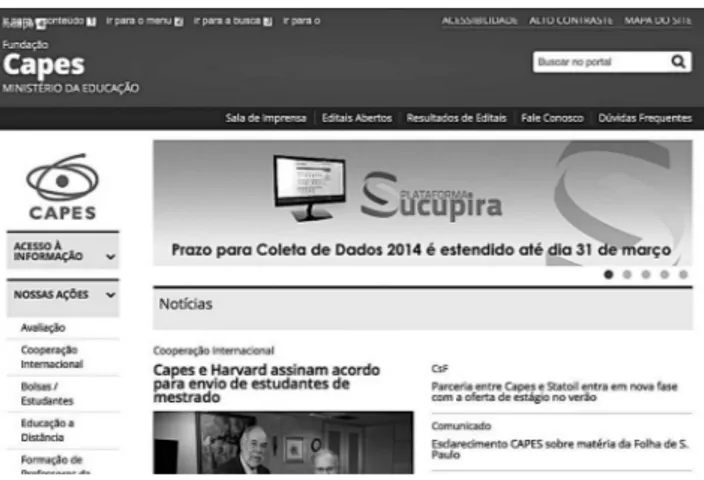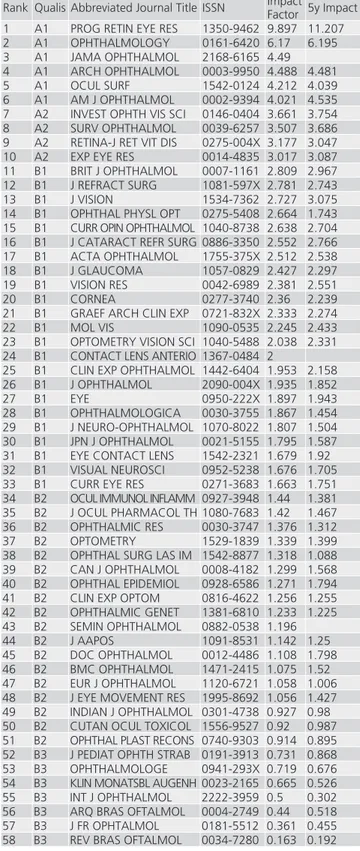70 Original Article
Rev. Col. Bras. Cir. 2015; 42(Suplemento 1): 70-72
JOURNAL ANALYSIS ON OPHTHALMOLOGY AND OTHERS
Análise dos periódicos da oftalmologia e outros
d
enisedeF
reitasINTRODUCTION
T
he Qualis is a tool used by Capes for stratification of scientific journals that post-graduate programs (PPG) uses for publication. The classification of these journals is divided by area of assessment, in this case, Medicine III or PPG surgical area. The Qualis is designed to meet the specific needs of the PPG evaluation system by CAPES and is based on information provided by the Data Collection/Sucupira Platform.The objective of this review is to update the knowledge of the means and methods to access and view the journals of the Qualis of Medicine III of CAPES.
METHODS
Consultation was done on the intellectual production clas-sification held in Qualis Periodicals available in http://www.capes. gov.br/avaliacao/instrumentos-de-apoio/classificacao-da-pro-ducao-intelectual1 and “Journal of Citation Report (JCR) “(ISI
Web of Knowledge, Thomson Reuters available inhttp://ad-min-apps-webofknowledge.ez69.periodicos.capes.gov.br/JCR/ JCR?RQ=LIST_SUMMARY_JOURNAL&cursor=412, both accessed
on March 22, 2015.
Special attempt was to analyze the way used by Qualis for ranking journals listed by all Medicine III post-graduate programs in their evaluation periods, and the impact factors obtained by the journals.
RESULT
Classification undergoes annual update process, stratified from A1, the highest, to A2; B1; B2; B3; B4; B5; C. The latter has zero weight in the evaluation process. The same journal can be classified into different Qualis in other areas, and this is no inconsistency, but expressed the assigned value in each area that one particular journal has. As CAPES points out, it is not the intention with this rating - that is specific to the process of evaluation of each area – to set the absolute quality of journals. The browser to access the classification and consulting Qualis areas, as well as disclosure of the criteria used for the journals classification, is named WebQualis. It can be accessed by going to the home web page of CAPES portal and choosing “Nossas Ações” by “Avaliação” page (Figure 1). Once on this page, in the end, there is a “link” to access the WebQualis (Figure 2).
FIGURE 1 - CAPES electronic site with the homepage where there is access to “Nossas Ações”
FIGURE 2 - CAPES electronic site with the homepage where, at the end, there is a “link” to access the WebQualis
Once in WebQualis page will be found on the far right “Consultar” with the options of “Classificação” or “Critérios Qualis por área”. In the latter, there is access to the document that explains the criteria of the area, in this case Medicine III, for the classification of journals. Once in the “Classificação” page, it can be consulted the journal for its ISSN, title, by rating/assessment area (journals A1, A2, etc.) or access to the full list of all journals.
Qualis does not provide only medical journals, because researchers must be open to the possibility of publish in jour-nals that do not fall within the medical field. Still, it does not provide the specific impact factor of each journal. For this,
From the Programa de Pós-Graduação em Oftalmologia e Ciências Visuais da Universidade Federal de São Paulo – UNIFESP (Post-Graduate Program in Ophthalmology and Visual Sciences, Federal University of São Paulo), São Paulo, SP, Brazil
DOI: 10.1590/0100-69912015S01025
A B S T R A C T
Objective: To update knowledge and methods to access and view the journals included in Qualis of CAPES Medicine III, and how to measure the impact factor. Method: Document review on the attempt to verify the way Qualis uses for ranking journals cited by the post-graduate programs of Medicine III in their evaluation periods, and the impact factors obtained by journals indexing base.
Results: The classification is annual and are ranking in strata ranging from A1, the highest, and A2; B1; B2; B3; B4; B5; C. The latter has zero evaluation weight. These strata take as reference the impact factor of the journals listed by the programs. The same journal can be classified into different Qualis in other areas, and this is no inconsistency, but expressed the assigned value, in each area, at that particular journal. The Impact Factor is measured using the Journal of Citation Report in Web of Knowledge website. Conclusion: Using the criteria established by WebQualis for stratification of journals there is a quality guidance of what is produced by the program and, based on it, can be made scientific comparison of program performance. Consulting the JCR is recommended because it defines exactly what is the journal’s impact factor; Qualis stratifies numerical intervals and not individual journal specificity.
71 Original Article
Rev. Col. Bras. Cir. 2015; 42(Suplemento 1): 70-72
71
TABLE 1 - Journals listed in the “Journal of Citation Report (JCR)” (ISI Web of Knowledge, Thomson Reuters) classified by Qualis and Impact Factor
Rank Qualis Abbreviated Journal Title ISSN Impact
Factor 5y Impact 1 A1 PROG RETIN EYE RES 1350-9462 9.897 11.207 2 A1 OPHTHALMOLOGY 0161-6420 6.17 6.195 3 A1 JAMA OPHTHALMOL 2168-6165 4.49 4 A1 ARCH OPHTHALMOL 0003-9950 4.488 4.481 5 A1 OCUL SURF 1542-0124 4.212 4.039 6 A1 AM J OPHTHALMOL 0002-9394 4.021 4.535 7 A2 INVEST OPHTH VIS SCI 0146-0404 3.661 3.754 8 A2 SURV OPHTHALMOL 0039-6257 3.507 3.686 9 A2 RETINA-J RET VIT DIS 0275-004X 3.177 3.047 10 A2 EXP EYE RES 0014-4835 3.017 3.087 11 B1 BRIT J OPHTHALMOL 0007-1161 2.809 2.967 12 B1 J REFRACT SURG 1081-597X 2.781 2.743 13 B1 J VISION 1534-7362 2.727 3.075 14 B1 OPHTHAL PHYSL OPT 0275-5408 2.664 1.743 15 B1 CURR OPIN OPHTHALMOL 1040-8738 2.638 2.704 16 B1 J CATARACT REFR SURG 0886-3350 2.552 2.766 17 B1 ACTA OPHTHALMOL 1755-375X 2.512 2.538 18 B1 J GLAUCOMA 1057-0829 2.427 2.297 19 B1 VISION RES 0042-6989 2.381 2.551
20 B1 CORNEA 0277-3740 2.36 2.239
21 B1 GRAEF ARCH CLIN EXP 0721-832X 2.333 2.274 22 B1 MOL VIS 1090-0535 2.245 2.433 23 B1 OPTOMETRY VISION SCI 1040-5488 2.038 2.331 24 B1 CONTACT LENS ANTERIO 1367-0484 2
25 B1 CLIN EXP OPHTHALMOL 1442-6404 1.953 2.158 26 B1 J OPHTHALMOL 2090-004X 1.935 1.852
27 B1 EYE 0950-222X 1.897 1.943
28 B1 OPHTHALMOLOGICA 0030-3755 1.867 1.454 29 B1 J NEURO-OPHTHALMOL 1070-8022 1.807 1.504 30 B1 JPN J OPHTHALMOL 0021-5155 1.795 1.587 31 B1 EYE CONTACT LENS 1542-2321 1.679 1.92 32 B1 VISUAL NEUROSCI 0952-5238 1.676 1.705 33 B1 CURR EYE RES 0271-3683 1.663 1.751 34 B2 OCUL IMMUNOL INFLAMM 0927-3948 1.44 1.381 35 B2 J OCUL PHARMACOL TH 1080-7683 1.42 1.467 36 B2 OPHTHALMIC RES 0030-3747 1.376 1.312 37 B2 OPTOMETRY 1529-1839 1.339 1.399 38 B2 OPHTHAL SURG LAS IM 1542-8877 1.318 1.088 39 B2 CAN J OPHTHALMOL 0008-4182 1.299 1.568 40 B2 OPHTHAL EPIDEMIOL 0928-6586 1.271 1.794 41 B2 CLIN EXP OPTOM 0816-4622 1.256 1.255 42 B2 OPHTHALMIC GENET 1381-6810 1.233 1.225 43 B2 SEMIN OPHTHALMOL 0882-0538 1.196 44 B2 J AAPOS 1091-8531 1.142 1.25 45 B2 DOC OPHTHALMOL 0012-4486 1.108 1.798 46 B2 BMC OPHTHALMOL 1471-2415 1.075 1.52 47 B2 EUR J OPHTHALMOL 1120-6721 1.058 1.006 48 B2 J EYE MOVEMENT RES 1995-8692 1.056 1.427 49 B2 INDIAN J OPHTHALMOL 0301-4738 0.927 0.98 50 B2 CUTAN OCUL TOXICOL 1556-9527 0.92 0.987 51 B2 OPHTHAL PLAST RECONS 0740-9303 0.914 0.895 52 B3 J PEDIAT OPHTH STRAB 0191-3913 0.731 0.868 53 B3 OPHTHALMOLOGE 0941-293X 0.719 0.676 54 B3 KLIN MONATSBL AUGENH 0023-2165 0.665 0.526 55 B3 INT J OPHTHALMOL 2222-3959 0.5 0.302 56 B3 ARQ BRAS OFTALMOL 0004-2749 0.44 0.518 57 B3 J FR OPHTALMOL 0181-5512 0.361 0.455 58 B3 REV BRAS OFTALMOL 0034-7280 0.163 0.192
DISCUSSION
Using the criteria established by WebQualis as guidance for stratification of journals that the areas use in the periodic evaluations, it is possible to quantify what is produced in the programs and, based on it, can be made scientific comparisons in post-graduate programs performance. In additional purpose, JCR consultation offers exactly what is the journal’s impact factor, as far as Qualis stratifies numerical intervals but not individual journal specificity.
These two consultations together give security to the program, and the possibility to quantify himself the quality of what was produced scientifically.
data not covered by the Qualis can be found on database “Journal of Citation Report (JCR)” (ISI Web of Knowledge, Thomson Reuters).
To access the JCR and to know the journals impact factor, must enter Portal de Periódicos CAPES/MEC, and the sector “Busca” to access the “Buscar Base” page. Once in the JCR (Figure 3) in the left option (“Select the JCR edition and year”) should be noted in the “JCR Science Edition” the year wanted to be searched, the most recent is 2013. To the right are the options “View the group of journals by”, “Search for a specific journal” or “View all journals”. To get journals in specifc area should be accessed “View the group of journals by” and in it choose the “subject category”, in this case Ophthalmology (Figure 4).
FIGURE 3 - Electronic site of “Journal of Citation Report (JCR)” (ISI Web of Knowledge, Thomson Reuters) in which, the option on left “JCR Science Edition” should mark the year wanted to be searched. On the right should be chosen “View the group of journals by”
FIGURE 4 - Electronic site of the JCR with the chosen Ophthalmology journals in the “View the group of journals by”
Once entering the Ophthalmology page can be arranged scientific journals for various items (journal title, total citations, etc.); in this case chooses the “impact factor” (Figure 5).
FIGURE 5 - JCR site with journals arranged by Impact Factor Currently the JCR list 58 specific scientific journals in the area of Ophthalmology. If the impact factors of them are analyzed by the average, obtains 2.109 and with the me-dian 1.801. The journal with highest impact factor is 9.897 (“Progress in Retinal and Eye Research”) and the lowest is 0.163 (Brazilian Journal of Ophthalmology). Stratification of journals in WebQualis for Medicine III in the 2010-2012 period
was determined as: A1 ≥4; A2 ≥ 2,85; B1 ≥1,6; B2 ≥0,8; B3 ≥0.01; B4 journals cited in Medline, SciELO, Lilac; B5 journals
72 Original Article
Rev. Col. Bras. Cir. 2015; 42(Suplemento 1): 70-72
REFERENCES
1. Classificação da produção intelectual. Qualis-Periódicos. Disponível em: http://www.capes.gov.br/avaliacao/instrumentos-de-apoio/ classificacao-da-producao-intelectual.
2. Journal of Citation Report (JCR) (ISI Web of Knowledge, Thomson Reuters). Disponível em: http://admin-apps-webofknowledge. ez69.periodicos.capes.gov.br/JCR/JCR?RQ=LIST_SUMMARY_JOUR-NAL&cursor=41
Recebido em: 19/02/2015
Aceito para publicação em: 12/09/2015 Conflito de interesses: nenhum Fonte de financiamento: nenhum
Endereço para correspondência: Denise de Freitas
dfreitas@uol.com.br
R E S U M O
Objetivo: Atualização do conhecimento dos meios e métodos de acessar e visualizar os periódicos do Qualis da Medicina III da CAPES e a mensuração do Fator de Impacto. Método: Buscou-se verificar a forma utilizada pelo Qualis para classificar os periódicos referidos pelos programas de pós-graduação da Medicina III em seus períodos de avaliação e os fatores de impacto obtidos pelas revistas em base indexadora. Resultados: A classificação é anual e são enquadrados em estratos que variam de A1, o mais elevado, a A2; B1; B2; B3; B4; B5; C. Este último tem peso zero. Esses estratos levam como referência o Fator de Impacto dos periódicos referidos pelos programas. Um mesmo periódico pode ter classificação em Qualis diferentes em outras áreas, e isto não constitui inconsistência, mas expressa o valor atribuído, em cada área, àquela determinada revista científica. O Fator de Impacto é mensurado navegando-se no site do Journal of Citation Report da Web of Knowledge. Conclusão: A utilização dos critérios estabelecidos pelo WebQualis para estrati-ficação dos periódicos é norteadora da qualidade do que se produz nos programas e, com base nela, pode-se fazer comparações de desempenho científico. Já a consulta ao JCR é complementarmente adequada de ser feita porque define com exatidão qual é o fator de impacto da revista, em função de que o Qualis estratifica faixas numéricas e não especificidade individual do periódico.

